2018 KIA K900 window
[x] Cancel search: windowPage 358 of 544

Driving your vehicle
5
5-93
- When a trailer or carrier is installed.
- When the temperature of the rearbumper is very high or low.
- When the sensors are covered by the vehicle, wall or a pillar of park-
ing lot.
- When your vehicle is backing up, if the detected vehicle approaches
your vehicle or also backs up.
- Small objects like shopping carts and baby carriages.
- If there is a vehicle with decreased ride height (lowered).
- When the vehicle is close to anoth- er vehicle.
- When the vehicle in the next lane moves two lanes away from my
vehicle OR when the vehicle two
lanes away moves to the next lane
from my vehicle.
- When exiting rearward from a parking space with pillars or metal
structures.
- When driving through a narrow road with many plants.
- When driving on wet surface. Outside rearview mirror may not alert the driver when:
- The outside rearview mirror hous- ing is damaged or covered with
debris.
- The window is covered with debris.
- The windows are severely tinted.
Pursuant to Code of Federal
Regulations, Title 47, Part 15
("FCC Rules").
Operation is subject to the following
two conditions:
1.This device may not cause harmful interference, and
2.This device must accept any inter- ference received, including inter-
ference that may cause undesired
operation.
KH USA 5:2018 4/12/2017 10:02 AM Page 93
Page 360 of 544
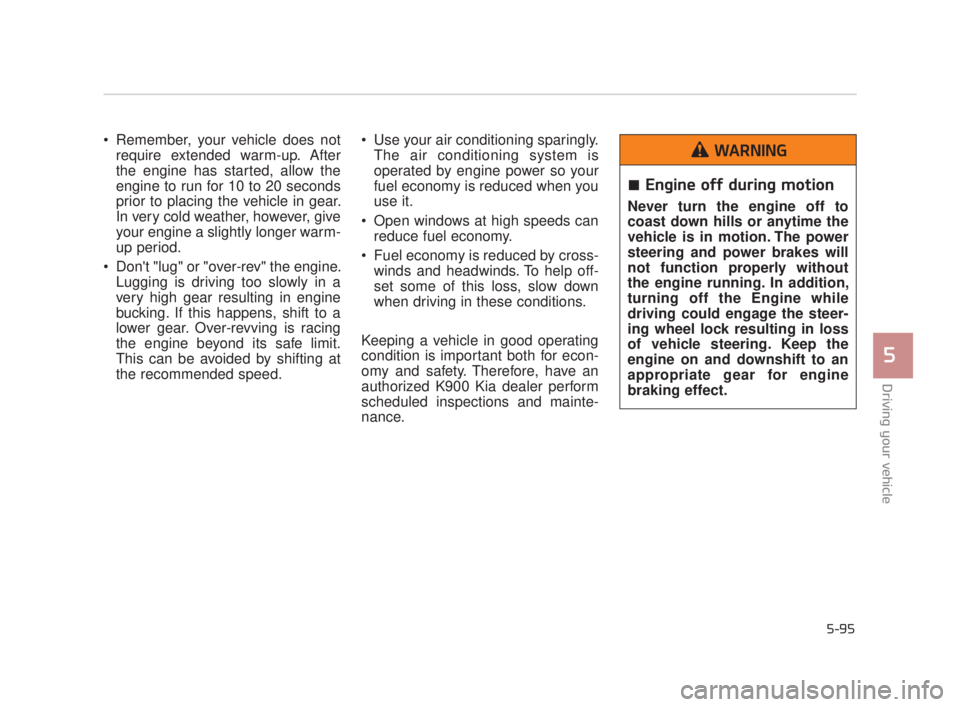
Driving your vehicle
5
5-95
Remember, your vehicle does notrequire extended warm-up. After
the engine has started, allow the
engine to run for 10 to 20 seconds
prior to placing the vehicle in gear.
In very cold weather, however, give
your engine a slightly longer warm-
up period.
Don't "lug" or "over-rev" the engine. Lugging is driving too slowly in a
very high gear resulting in engine
bucking. If this happens, shift to a
lower gear. Over-revving is racing
the engine beyond its safe limit.
This can be avoided by shifting at
the recommended speed. Use your air conditioning sparingly.
The air conditioning system is
operated by engine power so your
fuel economy is reduced when you
use it.
Open windows at high speeds can reduce fuel economy.
Fuel economy is reduced by cross- winds and headwinds. To help off-
set some of this loss, slow down
when driving in these conditions.
Keeping a vehicle in good operating
condition is important both for econ-
omy and safety. Therefore, have an
authorized K900 Kia dealer perform
scheduled inspections and mainte-
nance.
Engine off during motion
Never turn the engine off to
coast down hills or anytime the
vehicle is in motion. The power
steering and power brakes will
not function properly without
the engine running. In addition,
turning off the Engine while
driving could engage the steer-
ing wheel lock resulting in loss
of vehicle steering. Keep the
engine on and downshift to an
appropriate gear for engine
braking effect.
WARNING
KH USA 5:2018 4/12/2017 10:02 AM Page 95
Page 368 of 544
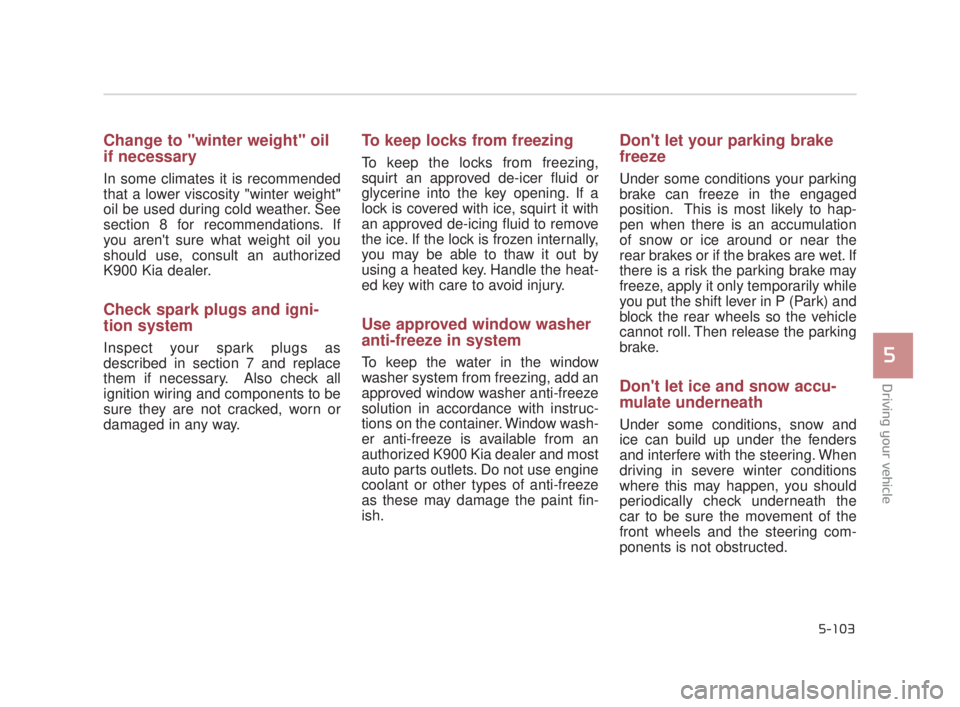
Driving your vehicle
5
5-103
Change to "winter weight" oil
if necessary
In some climates it is recommended
that a lower viscosity "winter weight"
oil be used during cold weather. See
section 8 for recommendations. If
you aren't sure what weight oil you
should use, consult an authorized
K900 Kia dealer.
Check spark plugs and igni-
tion system
Inspect your spark plugs as
described in section 7 and replace
them if necessary. Also check all
ignition wiring and components to be
sure they are not cracked, worn or
damaged in any way.
To keep locks from freezing
To keep the locks from freezing,
squirt an approved de-icer fluid or
glycerine into the key opening. If a
lock is covered with ice, squirt it with
an approved de-icing fluid to remove
the ice. If the lock is frozen internally,
you may be able to thaw it out by
using a heated key. Handle the heat-
ed key with care to avoid injury.
Use approved window washer
anti-freeze in system
To keep the water in the window
washer system from freezing, add an
approved window washer anti-freeze
solution in accordance with instruc-
tions on the container. Window wash-
er anti-freeze is available from an
authorized K900 Kia dealer and most
auto parts outlets. Do not use engine
coolant or other types of anti-freeze
as these may damage the paint fin-
ish.
Don't let your parking brake
freeze
Under some conditions your parking
brake can freeze in the engaged
position. This is most likely to hap-
pen when there is an accumulation
of snow or ice around or near the
rear brakes or if the brakes are wet. If
there is a risk the parking brake may
freeze, apply it only temporarily while
you put the shift lever in P (Park) and
block the rear wheels so the vehicle
cannot roll. Then release the parking
brake.
Don't let ice and snow accu-
mulate underneath
Under some conditions, snow and
ice can build up under the fenders
and interfere with the steering. When
driving in severe winter conditions
where this may happen, you should
periodically check underneath the
car to be sure the movement of the
front wheels and the steering com-
ponents is not obstructed.
KH USA 5:2018 4/12/2017 10:02 AM Page 103
Page 461 of 544

Maintenance
7
7-53
Disconnect the battery charger inthe following order.
1.Turn off the battery charger main switch.
2.Unhook the negative clamp from the negative battery terminal.
3.Unhook the positive clamp from the positive battery terminal.
Before performing maintenance or recharging the battery, turn off all
accessories and stop the engine.
The negative battery cable must be removed first and installed last
when the battery is disconnected.
Operation related to the battery should be done at an authorized
K900 Kia dealer.Reset items
Items should be reset after the bat-
tery has been discharged or the bat-
tery has been disconnected.
Auto up/down window (See section 4)
Sunroof (See section 4)
Driver position memory system (See section 4)
Trip computer (See section 4)
Climate control system (See section 4)
Clock (See section 4)
Audio (See section 4)
Power trunk (See section 4)
Battery in trunk
Your vehicle is equipped with a
battery in the trunk. For your
safety, avoid storing containers
with liquid in the trunk of the
vehicle. If the liquid leaks, this
could contact the battery and
create a risk of electrocution.
WARNING
KH USA 7:2018 4/14/2017 6:38 PM Page 53
Page 485 of 544

Maintenance
7
7-77
Fuse NameFuse rastingCircuit Protected
AUDIO 210AA/V & Navigation Head Unit, TMU
MODULE 310AA/C Control Module, Electro Chromic Mirror, Rear Seat Console Switch, Driver Haptic Control Module, Rear
CCS Control Module LH/RH, Driver/Passenger IMS Control Module, Driver Power Seat Module, Rear Seat
Warmer Control Module LH/RH, Rear Smart Junction Box (IPS Control Module)
MODULE 210ASteering Tilt & Telescopic Module, LDWS Camera Module, Crash Pad Switch, Stop Lamp Switch, A/T Console
Switch, Electric Parking Brake Switch, Console Switch, Smart Cruse Control Radar, Air Sus, TPMS, PAS
SPARE10ASpare
WIPER10AAuto Light & Rain Sensor
MODULE 110ABCM, Trunk Lid Main Switch, Low Panel Switch
MEMORY 210AExternal Buzzer, Driver Smart Connector, Passenger Smart Connector
DRV HEAT15ADriver Haptic Control Module, Driver CCS Module
PASS HEAT15APassenger CCS Module
WINDOW LH30ARear Power Window Module LH, Rear Power Window Module LH
HEADREST15AActive Headrest Sensor
BCM10ABCM, Multifunction Switch, Driver/Passenger Power Seat Switch, Rear Door Module LH/RH
EPB 215AElectric Parking Brake Module
P/HANDLE15ASteering Tilt & Telescopic Module
KH USA 7:2018 4/14/2017 6:39 PM Page 77
Page 496 of 544
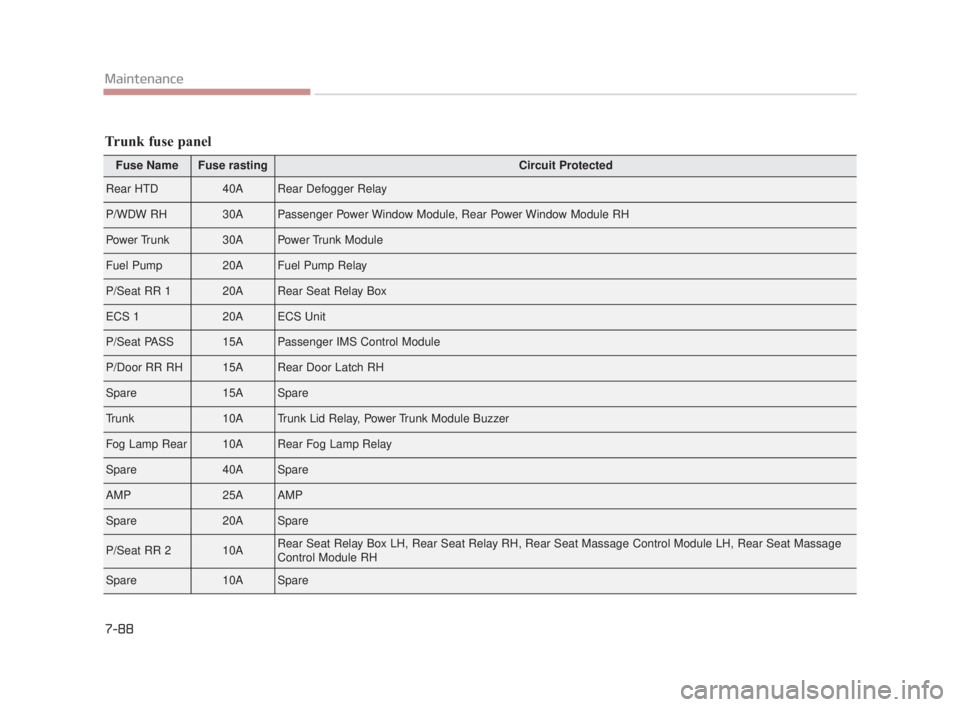
7-88
Maintenance
Fuse NameFuse rastingCircuit Protected
Rear HTD40ARear Defogger Relay
P/WDW RH30APassenger Power Window Module, Rear Power Window Module RH
Power Trunk30APower Trunk Module
Fuel Pump20AFuel Pump Relay
P/Seat RR 120ARear Seat Relay Box
ECS 120AECS Unit
P/Seat PASS 15APassenger IMS Control Module
P/Door RR RH15ARear Door Latch RH
Spare15ASpare
Trunk10ATrunk Lid Relay, Power Trunk Module Buzzer
Fog Lamp Rear10ARear Fog Lamp Relay
Spare40ASpare
AMP25AAMP
Spare20ASpare
P/Seat RR 210ARear Seat Relay Box LH, Rear Seat Relay RH, Rear Seat Massage Control Module LH, Rear Seat Massage
Control Module RH
Spare10ASpare
Trunk fuse panel
KH USA 7:2018 4/14/2017 6:40 PM Page 88
Page 498 of 544
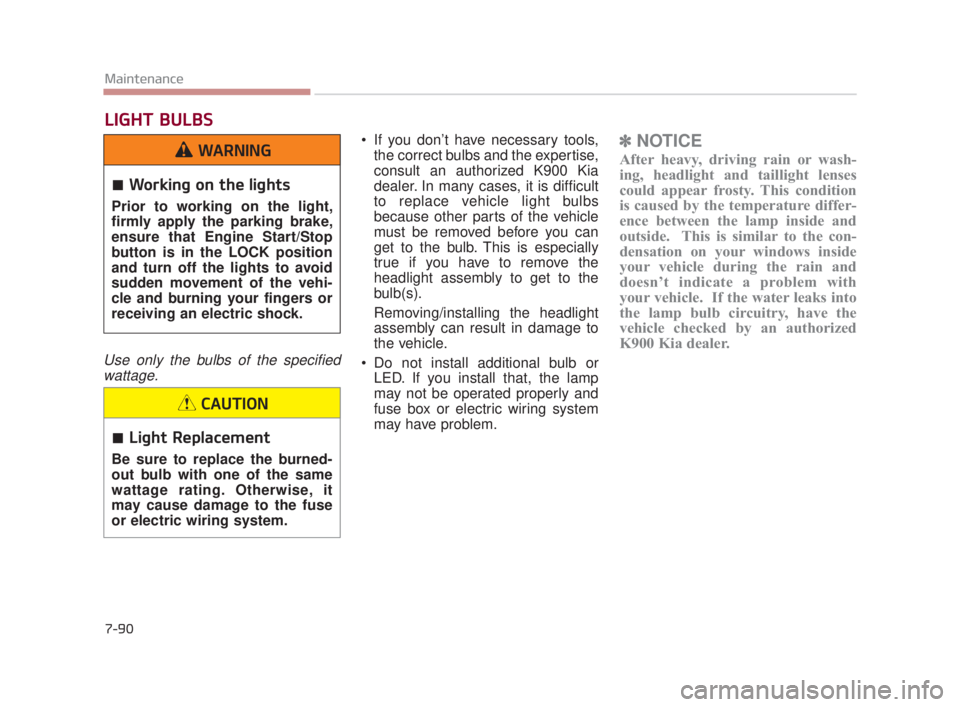
7-90
Maintenance
LIGHT BULBS
Use only the bulbs of the specifiedwattage.
If you don’t have necessary tools, the correct bulbs and the expertise,
consult an authorized K900 Kia
dealer. In many cases, it is difficult
to replace vehicle light bulbs
because other parts of the vehicle
must be removed before you can
get to the bulb. This is especially
true if you have to remove the
headlight assembly to get to the
bulb(s).
Removing/installing the headlight
assembly can result in damage to
the vehicle.
Do not install additional bulb or LED. If you install that, the lamp
may not be operated properly and
fuse box or electric wiring system
may have problem.✽ NOTICE
After heavy, driving rain or wash-
ing, headlight and taillight lenses
could appear frosty. This condition
is caused by the temperature differ-
ence between the lamp inside and
outside. This is similar to the con-
densation on your windows inside
your vehicle during the rain and
doesn’t indicate a problem with
your vehicle. If the water leaks into
the lamp bulb circuitry, have the
vehicle checked by an authorized
K900 Kia dealer.
Working on the lights
Prior to working on the light,
firmly apply the parking brake,
ensure that Engine Start/Stop
button is in the LOCK position
and turn off the lights to avoid
sudden movement of the vehi-
cle and burning your fingers or
receiving an electric shock.
WARNING
Light Replacement
Be sure to replace the burned-
out bulb with one of the same
wattage rating. Otherwise, it
may cause damage to the fuse
or electric wiring system.
CAUTION
KH USA 7:2018 4/14/2017 6:40 PM Page 90
Page 504 of 544
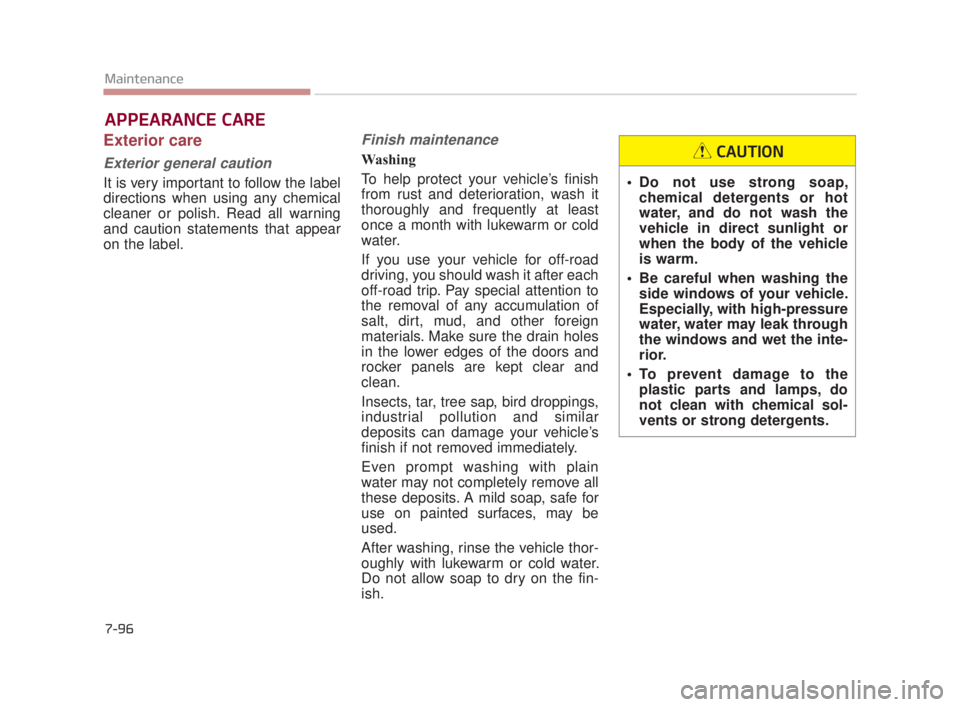
7-96
Maintenance
APPEARANCE CARE
Exterior care
Exterior general caution
It is very important to follow the label
directions when using any chemical
cleaner or polish. Read all warning
and caution statements that appear
on the label.
Finish maintenance
Washing
To help protect your vehicle’s finish
from rust and deterioration, wash it
thoroughly and frequently at least
once a month with lukewarm or cold
water.
If you use your vehicle for off-road
driving, you should wash it after each
off-road trip. Pay special attention to
the removal of any accumulation of
salt, dirt, mud, and other foreign
materials. Make sure the drain holes
in the lower edges of the doors and
rocker panels are kept clear and
clean.
Insects, tar, tree sap, bird droppings,
industrial pollution and similar
deposits can damage your vehicle’s
finish if not removed immediately.
Even prompt washing with plain
water may not completely remove all
these deposits. A mild soap, safe for
use on painted surfaces, may be
used.
After washing, rinse the vehicle thor-
oughly with lukewarm or cold water.
Do not allow soap to dry on the fin-
ish.
Do not use strong soap,chemical detergents or hot
water, and do not wash the
vehicle in direct sunlight or
when the body of the vehicle
is warm.
Be careful when washing the side windows of your vehicle.
Especially, with high-pressure
water, water may leak through
the windows and wet the inte-
rior.
To prevent damage to the plastic parts and lamps, do
not clean with chemical sol-
vents or strong detergents.
CAUTION
KH USA 7:2018 4/14/2017 6:40 PM Page 96